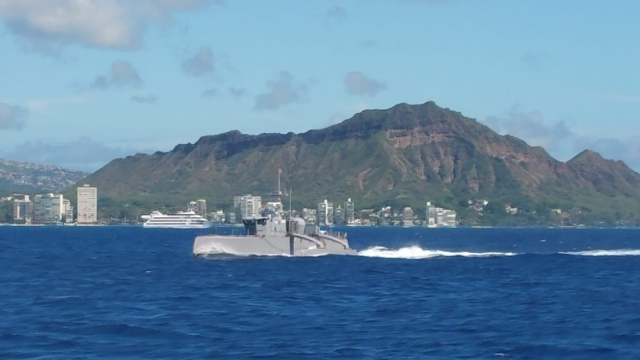Sea Hunter and Support for Beach Landings
Autonomous control systems developed for the Pentagon’s Sea Hunter unmanned ship could also help keep Marine Corps logisticians out of harm’s way during future amphibious landings, according to the company behind the technology.
Defense IT specialist Leidos is taking the kit it developed for the Sea Hunter medium unmanned surface vehicle, a 132-foot experimental wave-piercing trimaran, and applying it to the Marines’ Autonomous Littoral Connector program.
Leidos has already demonstrated the ability of a modified LCM-8 landing craft to run up a beach, stop for unloading/loading and return to sea without human intervention.
Now, with the elderly LCM-8s being phased out of service, the company is providing the same capabilities for the newer and larger Landing Craft Utility. The program is being overseen by the Marine Corps Warfighting Laboratory.
Addressing a naval seminar at the DSEI defense exhibition in London last week, Leidos Senior Vice President and Chief Technology Officer Tim Barton said, “the Warfighting Lab asked us to look at the autonomous logistics mission. When the Marine Corps attacks an objective on land from a sea base, what they’d like to do is have all the logistics come up on the beach fully autonomously.”
With seafloor mapping an essential precursor to any amphibious assault, Barton said that Leidos had also demonstrated an autonomous bathymetric survey capability using a 40-foot boat fitted with a multibeam sonar and moving vessel profiler.
If the quality of the bathymetric data was disrupted, he said, the boat would wait for the problem to be fixed before retracing its route and gathering fresh data. In addition, the platform had covertly launched and recovered an unmanned underwater vehicle from a submerged towed dock, also without human assistance.
The autonomous systems were developed by Leidos for Sea Hunter, which was conceived and built as a prototype for DARPA’s Anti-Submarine Warfare Continuous Trail Unmanned Vessel (ACTUV) program.
Fully complaint with obstacle-avoidance and collision regulations, the ship was transferred to the Office of Naval Research in January 2018 for general science and technology testing. Last year it became the first vessel to sail autonomously from San Diego, Calif., to Pearl Harbor, Hawaii, and back again.
For the complete article, see the following:
DSEI: Sea Hunter’s Autonomous Controls Could Support Unmanned Beach Landings

